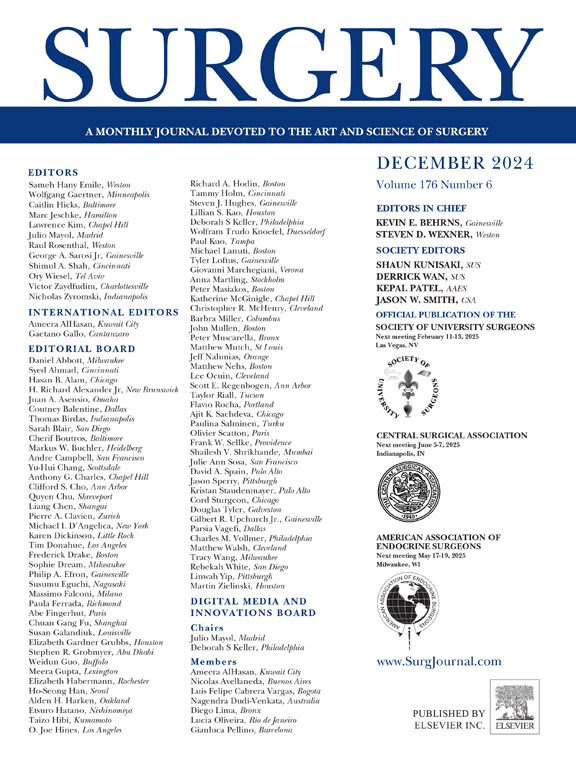Oncological outcomes of palliative minimally invasive distal pancreatectomy for unexpected metastatic pancreatic ductal adenocarcinoma: A single-center experience
IF 3.2
2区 医学
Q1 SURGERY
引用次数: 0
Abstract
Background
The benefits of palliative minimally invasive distal pancreatectomy for patients with unexpectedly metastatic pancreatic ductal adenocarcinoma have not been previously studied. This retrospective study compared the outcomes of palliative minimally invasive distal pancreatectomy with those of minimally invasive biopsy in these patients.
Methods
We reviewed the records of 46 patients with unexpected metastasis of left-sided pancreatic ductal adenocarcinoma that were discovered during surgery between 2005 and 2019. Nineteen patients underwent palliative resection (minimally invasive distal pancreatectomy group), whereas 27 patients underwent only minimally invasive biopsy (minimally invasive biopsy group). Demographic, clinical, and operative data, as well as survival rates, were compared between the 2 groups.
Results
Major complications (Clavien-Dindo grade ≥3) were comparable between the 2 groups (11.8% vs 5.6%; P = .603). Postoperative chemotherapy was administered to 84.2% of the minimally invasive distal pancreatectomy group and 77.8% of the minimally invasive biopsy group (P = .716). The minimally invasive distal pancreatectomy group had a higher completion rate of first-line palliative chemotherapy (42.9% vs 8.7%; P = .007) and a higher 2-year survival rate (36.8% vs 18.8%; P = .004). In multivariate analysis, survival was associated with completion of first-line chemotherapy (hazard ratio: 2.962; P = .003) and maintenance chemotherapy for over 12 months (hazard ratio: 2.339; P = .010). Gastric outlet obstruction was less prevalent in the minimally invasive distal pancreatectomy group (5.3% vs 25.9%, P = .037).
Conclusion
Palliative minimally invasive distal pancreatectomy may improve survival and facilitate the continuation of chemotherapy in selected patients with unexpected metastatic pancreatic ductal adenocarcinoma. However, the small sample size and potential selection bias limit the generalizability of these findings. Larger, prospective, multicenter studies are needed to confirm the role of minimally invasive distal pancreatectomy and to establish optimal management strategies for these patients.

求助全文
约1分钟内获得全文
求助全文
来源期刊

Surgery
医学-外科
CiteScore
5.40
自引率
5.30%
发文量
687
审稿时长
64 days
期刊介绍:
For 66 years, Surgery has published practical, authoritative information about procedures, clinical advances, and major trends shaping general surgery. Each issue features original scientific contributions and clinical reports. Peer-reviewed articles cover topics in oncology, trauma, gastrointestinal, vascular, and transplantation surgery. The journal also publishes papers from the meetings of its sponsoring societies, the Society of University Surgeons, the Central Surgical Association, and the American Association of Endocrine Surgeons.
 求助内容:
求助内容: 应助结果提醒方式:
应助结果提醒方式:


